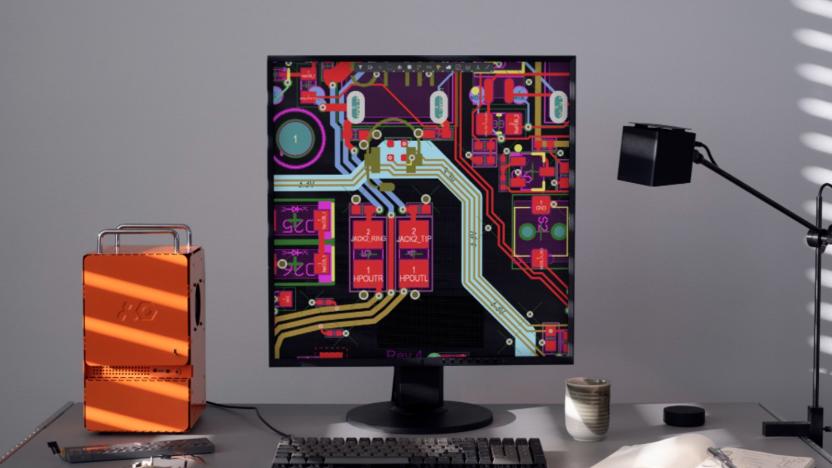ITX
Latest

Teenage Engineering made a mini ITX case called Computer–1
“It’s not a ground-breaking PC case, but we like it, and use it every day.”

J&W announces M001 Cedar Trail nettop, to keep desks and ears happy
If you like your computing to be neither seen, nor heard (or less seen and less heard), J&W has announced another bantam slab of nettop for your consideration. On the inside there's a choice of Cedar Trail D2550, N2800 and N2600 dual-core options, with support for up to 4GB of DDR3 RAM. Diminutive machines don't mean lack of I/O, and in this case you'll be getting three USB ports, a multicard reader, LAN, HDMI, VGA and RS232. Fanlesstech points out that it's actually a nano-ITX system, which measuring in at only 135 x 128 x 45 mm means it can be tucked away into even more convenient crevices. Just make sure not to hide it away too securely, else that 802.11.n WiFi might suffer.

Zotac's Zboxes are small, Ion-fueled, and cheap
If you're like us, you're constantly on the hunt for the perfect small computer. Now, we're not saying we've found it in this new set of Zotac Zboxes... but we do like where they're coming from. The minimal slivers pack Ion chipsets along with Intel CULV CPUs, making for a power-sipping experience that can actually push a couple of pixels (a couple, not many more). The company is dishing out a few varieties of the mini PCs, all loaded with some variation of Intel's Celeron processors. The HD series (the NS21 and ND22) pack a Celeron 743 or SU2300 CULV (respectively), DDR3 RAM slots, a 2.5-inch hard drive slot, HDMI and DVI-I ports, along with NVIDIA's Ion GPU. There's also an ITX series, all sporting those same CPUs, a single PCI Express x16 slot, a handful of SATA / eSATA hookups, and HDMI, DVI-D, and VGA connections. All the systems have a slew of USB ports, the boxes can be mounted in four different positions (including on the back of a monitor), and though retail pricing hasn't been announced, it looks like at least the ND22 should list for around $270. Hit the source link for all the details, and More Coverage for a review.

Via's teeny tiny Mobile-ITX EPIA-T700 system board demonstrated twice (video)
We've been hearing of Via's Mobile-ITX technology for quite some time now, but it only became officially official last month and now we're seeing the thing in the silicon for the first time. The company has put together a little demo video that we've included below, showing off its minuscule 6cm x 6cm system board, about half the size of a Pico-ITX. But, there are two problems. The first is that this current Mobile-ITX board (the EPIA-T700) has no I/O connectors on it, meaning it must be mounted onto a larger carrier board if you want to do anything with it -- but hopefully that can be integrated into mobile devices and shrunk. The second problem? That the presenter flubbed the demonstration and someone forgot to edit the first take out of the video. See the frustration for yourself at the 1:15 mark after the break.

Portwell ships Atom-based nano-ITX motherboard
With all these nettops, netbooks and plain ole motherboards flying every which-away, it's hard to say if Portwell's Atom-based nano-ITX board really is the first, but it's close enough to count in our book. Utilizing all sorts of legerdemain and black magic, the engineers at Portwell were able to craft a Linux-friendly mobo that measures just 4.72- x 4.72- x 0.65-inches and supports Intel's Silverthorne Atom while including six USB 2.0 ports, embedded audio and a gigabit Ethernet jack. The Nano-8044 can be ordered in two flavors -- the Z530, which packs a 1.6GHz CPU, or the Z510, which clocks in at 1.1GHz. As you could likely guess, this one's aimed primarily at point-of-sale machines, digital signage devices and other commercial applications, and the sub-10-watt power draw should keep energy costs to a minimum. Oh, and it should totally play Doom in a pinch.[Via LinuxDevices]

Make your own laptop using Mini-ITX components
The main appeal of laptops tends not to be their upgradability: that's what desktops are for, right? Well, if the recent trend for "deskbooks" is anything to go by, then that assessment isn't true anymore. Entering the same league as commercial 19- and 20-inch desktop replacements, and tipping the performance vs. portability scale heavily towards the "need two people to carry it" category is Torquil Harkness' "ITX-Laptop," a computer designed around Mini-ITX components so that it simultaneously maintains a modicum of portability alongside full upgradability. Torquil admits that the end result could have been far smaller had he used Nano-ITX -- or Pico-ITX -- components, but in order to make it "as powerful as a regular desktop" he decided to go for larger parts. Despite Torquil's statement that performance was the aim, we'd have to say on first glance at the specs -- 2GHz, 1GB RAM, and a PCI-based ATI Radeon 9200 graphics card -- that some degree of compromise took place. Still, we believe him when he claims that he "could slot in a motherboard with PCI Express in the future" because this thing's wide open for future upgrades, and that's the point. Never mind the limited specs or the questionable chrome paint job: just lean forward, take a closer look at those computer guts and think "I can do that too." That's the way to stick it to the man.[Via BoingBoing]



